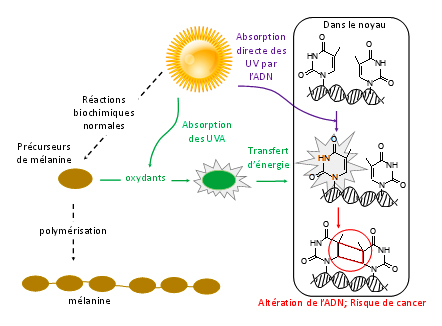Research work shows that oxidative species and free radicals generated by some of the solar radiation - UVA - when exposed to the sun react with the precursor molecules of melanin, located in the cells synthesizing the sunscreen (the melanocytes). These oxidized precursor molecules then decay, releasing energy that can be transmitted to the DNA, then generating alterations (creation of additional chemical bonds in DNA). This type of alteration, the same as those produced by the direct effect of solar UV is causing mutations causing the appearance of melanoma.
Moreover, by measuring the amount of generated alterations in the DNA of melanocytes over time, researchers have found that these phenomena occur not only during direct exposure but endure several hours, even after the cells "sheltered" from UVA.
We used a mass spectrometry method, developed at the Institute for Nanoscience and Cryogenics to measure the amount of damage generated in the DNA at different times after direct UV exposure. Teams from our laboratory working for ten years on the photochemistry of DNA, expertise born of their expertise in systems analysis and reconciliation of work in chemistry and biology. They participated in the demonstration studies of the danger of UVA.
These new data provide a better understanding of skin carcinogenesis mechanisms and also allow to refine the photoprotection of messages, for example against UVA, often considered less harmful than UVB.

Diagram of the photo-biological mechanisms triggered by the exposure of the skin to radiation from the sun. While the normal operation of precursor molecules of melanin has a photoprotective effect against solar UV, these molecules can lead to alterations in the DNA in the case of absorption of part of the UVA radiation, and several hours after direct exposure to radiation.
© CEA